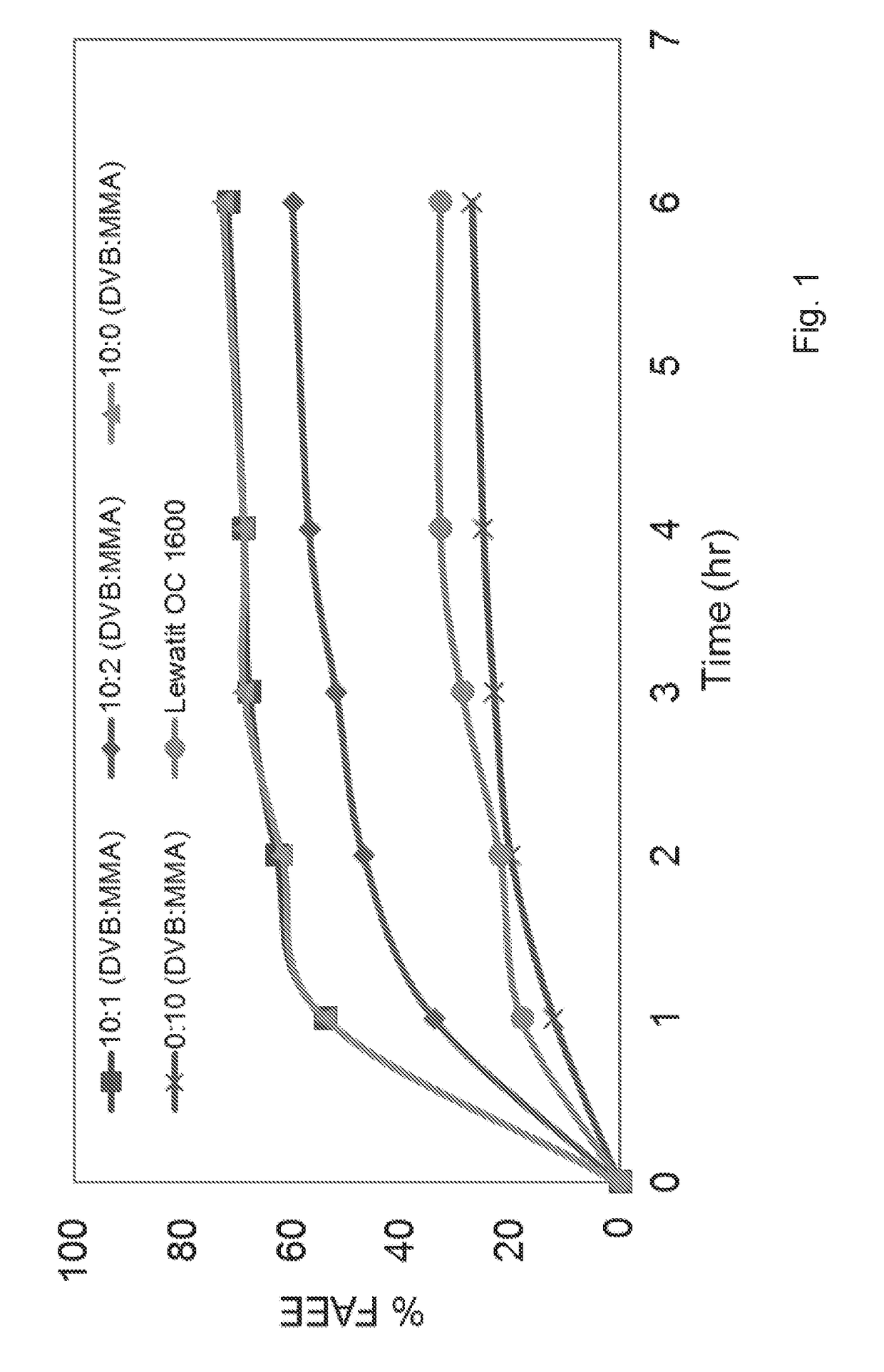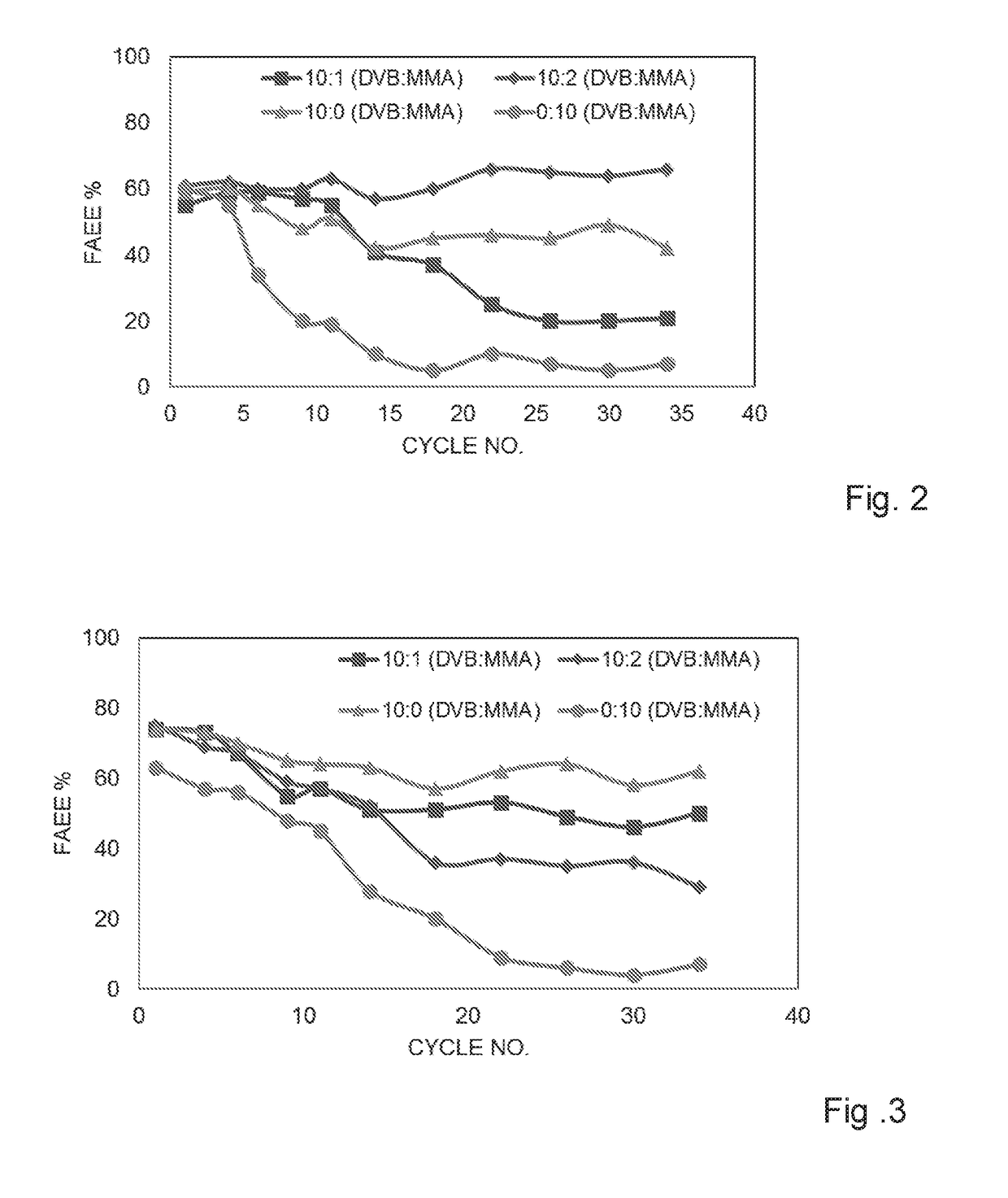ENZYMATIC ENRICHMENT OF n-3 FATTY ACIDS IN THE FORM OF GLYCERIDES
a technology of glyceride and n-3 fatty acids, which is applied in the field of compositions of matter comprising glycerides enriched with n3 fatty acid moieties, can solve the problems of reducing the recovery yield of n-3 fatty acids
- Summary
- Abstract
- Description
- Claims
- Application Information
AI Technical Summary
Benefits of technology
Problems solved by technology
Method used
Image
Examples
example 1
on of Immobilized Lipases
[0116]Lipases in this work were used in either free form or immobilized on different supports, including microporous silica, polymeric adsorbents of various extents of hydrophilic and hydrophobic characteristics, and on ion exchange resins. Below is a list of the supports used for the immobilization of the different lipases tested in this work.
[0117]Enzyme immobilization procedure can be as follows:
Lipase (10,000 units of lipase) derived from different suitable sources as specified, was dissolved in phosphate buffer solution (10 ml) of 0.1M and pH 7. Enzyme support (2 g) in beads form, with particle size distribution in the range of 100-1500 micron, or powderous form (less than 100 micron) was introduced into the enzyme solution. The mixture was shaken for 4-12 hours at room temperature. The enzyme immobilized on the support was filtered off from the solution. Optionally, the filtered enzyme was washed with cold acetone and then dried in a desiccator or a ly...
example 2
Preparation of n-3 Fatty Acids Concentrates in the Form of Glycerides
[0126]Lipase derived from Candida antarctica A (CALA), (15,000 units, NovoCor AD L, Novozymes, Denmark) in its free form or immobilized on each of the six different enzyme supports (Ig) according to Example 1 (designated in the Tables below as “free” or by support number), was contacted with refined fish oil (10 g) (FFAs content below 0.3%, n-3 fatty acids level 30%, EPA 18% and DHA12% w / w) by mixing or shaking, and ethanol (2 g) was added into the reaction system (oil-enzyme mixture) in three equivalent batches each 1 hour apart. The water content in the reaction mixture was adjusted to 3% by weight of oil, by adding the required amount of water or alkaline aqueous buffer solution so that the pH of the reaction medium is in the range of 5-9. The reaction was conducted at 30° C. The reaction products were quantified by gas chromatography at different time intervals. Tables 1, 2 and 3 below show the distribution of ...
example 3
Preparation of n-3 Fatty Acids Concentrates in the Form of Glycerides
[0134]Lipase derived from Alcaligenes sp. (10,000 units, lipase QLM™, Meito Sangyo, Japan) in its free form or immobilized on the different enzyme supports (1 g) as in Example 1, the various enzyme preparations were each contacted by mixing or shaking with refined fish oil of FFAs content below 0.3% (10 g) containing 30% n-3 fatty acids, and ethanol (2 g) was added into the reaction system (oil with enzyme) in three equivalent batches each 1 hour apart. The water content in the reaction mixture was adjusted to 2% by weight of oil by adding the required amount of water or alkaline aqueous buffer solution so that the pH of the reaction medium is in the range of 5-9. The reaction was conducted at 30° C. The reaction products were quantified by gas chromatography at different time intervals.
[0135]After 6 hours of stirring the immobilized lipase preparation was filtered off and the reaction mixture was flash evaporated ...
PUM
| Property | Measurement | Unit |
|---|---|---|
| temperature | aaaaa | aaaaa |
| temperature | aaaaa | aaaaa |
| pH | aaaaa | aaaaa |
Abstract
Description
Claims
Application Information
 Login to View More
Login to View More - R&D
- Intellectual Property
- Life Sciences
- Materials
- Tech Scout
- Unparalleled Data Quality
- Higher Quality Content
- 60% Fewer Hallucinations
Browse by: Latest US Patents, China's latest patents, Technical Efficacy Thesaurus, Application Domain, Technology Topic, Popular Technical Reports.
© 2025 PatSnap. All rights reserved.Legal|Privacy policy|Modern Slavery Act Transparency Statement|Sitemap|About US| Contact US: help@patsnap.com


